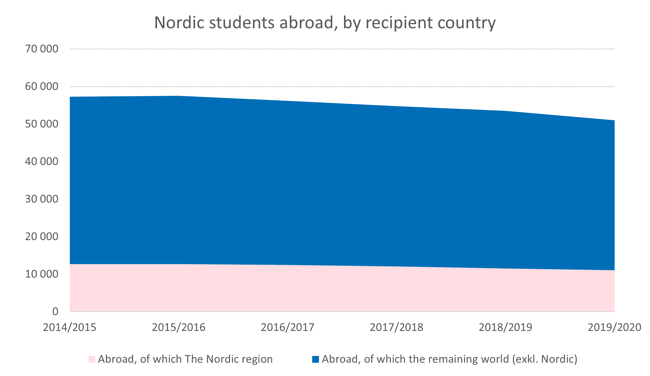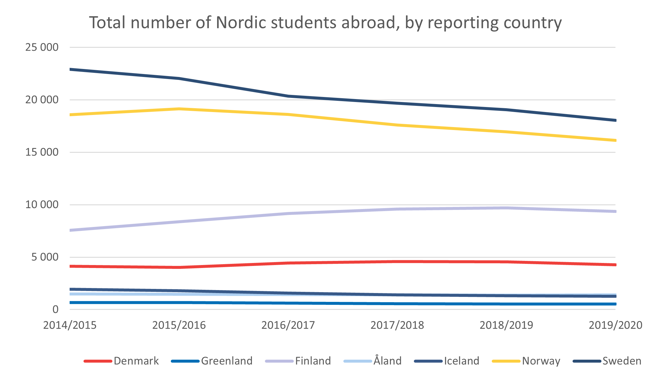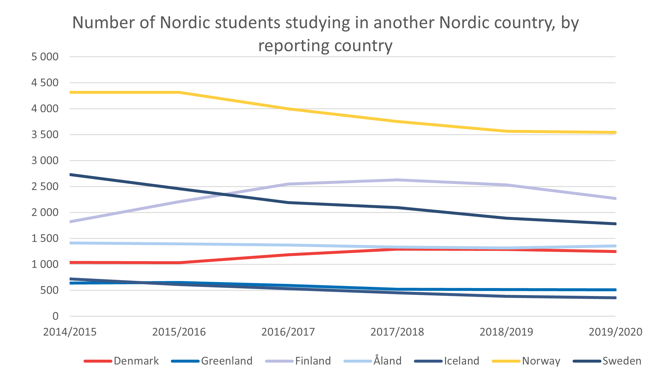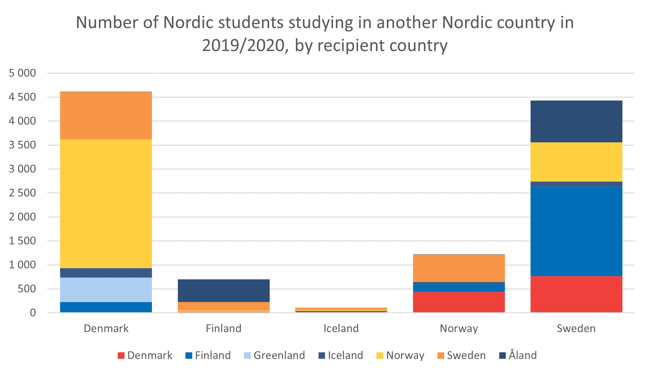Mobility in the Nordic region III – Studying abroad
The number of Nordic students studying abroad has been in decline for the past years. In the academic year 2019/2020 a total of 51,000 Nordic students chose to obtain their full education abroad. This is a decrease with five percent compared to the previous year, and almost twice the decline of previous years, most likely in parts caused by the ongoing pandemic.
In the academic year 2015/2016 over 57,000 Nordic students obtained their full education abroad (exchange studies are excluded and data is limited to students who receive financial support). Since then, the number of students has decreased by on average two percent per year until last year, 2019/2020, when the decrease in students was five percent and the number of students obtaining their full education abroad was down to 51,000.

Source: Nordic Statistics Database, EDUC14 Number of students abroad by reporting country, location of study, time and unit.
When analysed by reporting country (home country of the students) a decrease in 2019/2020 can be noted for six of seven countries for which there is data available [1], varying from just under two percent in Greenland [2] to just over six percent in Denmark. The only country with a positive trend in 2019/2020 is Åland [3], where the number of students abroad increased by just under three percent after having declined four years in a row. It is important to note that no university education is offered on Åland, students must go abroad to study at that level.
In previous years positive trends can be seen for Denmark and Finland, while the decrease in 2019/2020 was smaller than the average for previous years for Greenland and Iceland. In Norway and Sweden there has been a steady decrease over time, but the pace increased in 2019/2020 compared to the previous average.

Source: Nordic Statistics Database, EDUC14 Number of students abroad by reporting country, location of study, time and unit.
Studying in another Nordic country is especially popular among Norwegian students, even though there has been a decline over time. In the same way declines can be noted for Sweden, Greenland and Iceland. Åland has also had a decline but reported an increase of over three percent in 2019/2020. In Denmark and Finland, a positive trend can be seen in the first years reported, but this turned to declines in both countries in 2018/2019.

Source: Nordic Statistics Database, EDUC14 Number of students abroad by reporting country, location of study, time and unit.
Denmark and Sweden received the largest number of students from other Nordic countries in the academic year 2019/2020, about 4,500 each. In Denmark, almost 60 percent of the students came from Norway, 20 percent from Sweden and 10 percent from Greenland [2]. In Sweden just over 40 percent came from Finland and around 20 percent each from Åland, Norway and Denmark. The country with the smallest number of Nordic students was Iceland with a total of 107 students, just under half of these from Sweden.

Source: Nordic Statistics Database, EDUC13 Number of students abroad by reporting country, recipient country and time.
The distribution of Nordic students between recipient countries is unchanged compared to the previous year, thus showing no sign of having been affected by the pandemic.
[1] Please note that Faroe Islands are not included in the analysis as no data is available. As many Faroese students take their higher education in Denmark this implies that the number of students from other Nordic countries or self-governing regions in Denmark is underestimated.
[2] For Greenland “Abroad, of which The Nordic region” refers only to schools in Denmark, all other Nordic countries are included in “Abroad, of which the remaining world”. There may thus be Greenlandic students in the other Nordic countries who are not included in this analysis.
[3] Please note that for Åland data refers to calendar years, not academic years. Furthermore, exchange students are included.